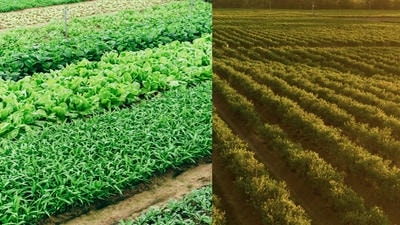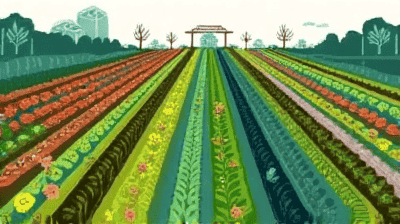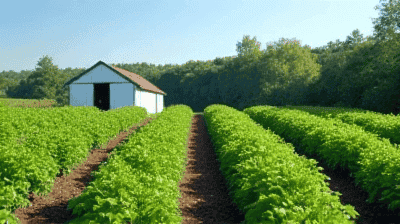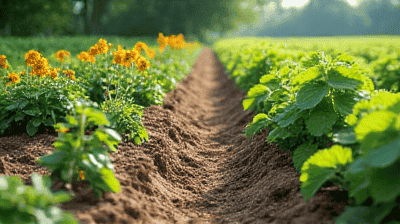
In recent decades, the global agricultural landscape has been dominated by monoculture—growing a single crop over extensive areas year after year. While this approach has proven efficient for producing high yields in the short term, it poses significant risks to long-term sustainability, soil health, and ecosystem resilience. In contrast, polyculture—a farming practice that involves growing multiple crops in the same space—offers an array of benefits that enhance the resilience of farms and food systems.
Monoculture refers to the agricultural practice of cultivating a single crop species in a given area for consecutive years. This technique has become prevalent due to its perceived advantages, including:
Simplified Management: Monoculture allows farmers to focus on one crop, simplifying planting, maintenance, and harvesting processes.
High Yields: By optimizing conditions for a specific crop, farmers can maximize yields in the short term.
Economies of Scale: Large-scale monoculture operations can achieve cost savings through bulk production and streamlined logistics.
Despite its apparent advantages, monoculture carries significant long-term risks:
Soil Degradation: Continuous cultivation of the same crop depletes specific nutrients, leading to soil degradation and reduced fertility.
Pest and Disease Vulnerability: Monocultures are more susceptible to pests and diseases that target specific crops, resulting in increased reliance on chemical pesticides.
Biodiversity Loss: Dominating landscapes with a single crop reduces biodiversity, impacting local ecosystems, wildlife habitats, and pollinator populations.
Economic Risks: Monoculture can lead to economic vulnerability, as farmers depend on a single crop's market performance, exposing them to market fluctuations and price drops.

Polyculture involves cultivating multiple species of crops together in the same space. This practice can take various forms, including intercropping (growing different crops in alternating rows), agroforestry (integrating trees with crops), and cover cropping (planting non-harvested crops to enhance soil health). The key characteristics of polyculture include:
Diversity: Multiple crop varieties are grown together, promoting ecological resilience.
Synergy: Different crops can complement each other’s growth, with some providing nutrients for others, improving pest and weed management.
Soil Health: Polyculture practices often enhance soil health through organic matter addition and nutrient cycling.
The advantages of polyculture extend beyond environmental benefits to encompass economic and social dimensions:
Enhanced Resilience: Diverse systems are more adaptable to changes in climate and pest pressures. If one crop fails, others may still thrive, providing security for farmers.
Improved Soil Health: Rotating crops and maintaining ground cover helps build soil organic matter, increases microbial diversity, and improves nutrient cycling.
Pest and Disease Management: A diverse cropping system disrupts pest pathways and reduces the spread of diseases, minimizing the need for chemical inputs.
Biodiversity Preservation: Polyculture supports ecosystem health by promoting biodiversity among plants, insects, and soil organisms.
Economic Stability: Diverse farms can mitigate market risks by offering multiple products, resulting in more stable income streams for farmers.
The shift toward monoculture began in the mid-20th century with the advent of industrial agriculture. Advances in mechanization, synthetic fertilizers, and pesticides facilitated the widespread adoption of monoculture practices. However, as the negative impacts of these practices became evident, interest in alternative approaches, such as polyculture, began to grow.
Transitioning from monoculture to polyculture requires thoughtful planning and implementation. Here are key steps farmers can take:
Assessment of Land and Resources: Understanding the specific conditions of the land, including soil types, climate, and water availability, is essential for successful polyculture design.
Crop Selection: Choose a diversity of crops that complement each other in terms of nutrient needs, growth habits, and pest resistance. This selection should consider local market demand as well.
Designing the System: Implement intercropping, agroforestry, or companion planting strategies to optimize land use and create synergies among crops.
Soil Health Management: Focus on building soil health through organic amendments, cover cropping, and reduced tillage to support diverse crop growth.
Monitoring and Adaptation: Regularly assess the performance of the polyculture system to identify successes and areas for improvement. Adapt practices based on observations and feedback.

The Rodale Institute, located in Pennsylvania, is a leader in regenerative organic farming research. Their polyculture experiments highlight the benefits of diverse cropping systems, demonstrating that farms with a mix of crops can improve soil health and increase yields.
Run by farmer Joel Salatin, Polyface Farm in Virginia employs a rotational grazing system that integrates livestock with diverse pasture species. This approach enhances soil fertility, reduces pests, and produces high-quality meats and vegetables while preserving the environment.
Plymouth Creek Farm in Minnesota practices community-supported agriculture (CSA) with a focus on polyculture. By growing a variety of vegetables alongside herbs and flowers, the farm promotes biodiversity, provides a diverse harvest for members, and supports local pollinators.
As consumer preferences shift towards sustainable and organic products, polyculture farms are well-positioned to meet this demand. Farmers can tap into niche markets for diverse product offerings, such as heirloom vegetables or specialty crops.
Diverse systems can lead to reduced input costs. By minimizing the use of synthetic fertilizers and pesticides, farmers can achieve cost savings while enhancing their ecological impact. Additionally, diverse farms may require less irrigation due to improved soil health and water retention.
Polyculture allows farmers to diversify their income streams. By producing multiple crops, farmers are less vulnerable to market fluctuations and crop failures. A diverse portfolio can lead to greater financial stability over time.

Polyculture systems enhance resilience to climate change by promoting biodiversity and improving soil health. Diverse ecosystems are better equipped to adapt to changing weather patterns, mitigating the impacts of droughts, heavy rainfall, and other climate-related challenges.
By supporting a wide variety of plant and animal species, polyculture contributes to the preservation of biodiversity. This not only benefits farms but also strengthens local ecosystems and wildlife habitats.
Polyculture provides essential ecosystem services, including:
Pollination: Diverse crops attract a range of pollinators, enhancing pollination services for all plant species.
Soil Stabilization: Deep-rooted plants reduce soil erosion and improve water infiltration, contributing to soil health.
Nutrient Cycling: Various crops contribute to nutrient cycling and improve soil fertility.
Polyculture can enhance local food systems by increasing the availability of diverse products for consumers. As more farms adopt polyculture practices, communities can benefit from fresh, locally grown produce, reducing reliance on agribusiness and long-distance supply chains.
Polyculture farms often involve community-supported agriculture (CSA) models, where consumers engage directly with farmers. This connection fosters relationships, increases awareness of sustainable practices, and encourages local food purchasing.
Diverse farms can serve as educational hubs, showcasing sustainable agricultural practices and raising awareness about the importance of biodiversity and resilient food systems. Workshops and farm tours can engage the community and inspire others to adopt similar practices.
Many farmers lack training and experience with polyculture practices. Education and extension services are essential to provide support and resources for those looking to transition from monoculture.
Implementing polyculture systems may require initial investments in seeds, infrastructure, and training. Financial resources and access to grants or incentives can help support farmers during this transition.
Small-scale polyculture farms may face challenges in accessing markets and distribution channels. Building networks and partnerships can enhance market opportunities and improve the overall success of diverse farms.
Governments can play a crucial role in promoting polyculture by providing incentives for sustainable practices. Financial assistance, grants for transitioning to polyculture, and supportive policies can help farmers make the shift.
Programs that encourage biodiversity and ecosystem conservation can support polyculture initiatives. These programs might include technical assistance for farmers and education on the benefits of diverse cropping systems.
Investing in research and education around polyculture practices is essential for advancing sustainable agriculture. Collaborative efforts between agricultural research institutions, universities, and farming communities can foster innovation and knowledge-sharing.
The transition from monoculture to polyculture represents a significant opportunity to create more resilient and sustainable agricultural systems. By embracing diversity in crops, polyculture not only enhances soil health and ecosystem resilience but also offers economic benefits for farmers and communities. As we face the pressing challenges of climate change, food security, and biodiversity loss, polyculture emerges as a promising solution for a brighter agricultural future.
Incorporating polyculture practices into our farming systems can lead to a healthier planet, abundant and nutritious food, and vibrant communities. As consumers, advocates, and producers, we can work together to support the shift towards diverse and resilient farms for generations to come.